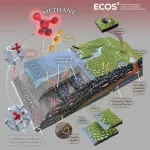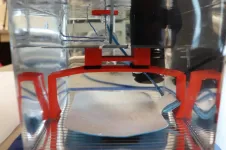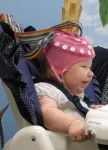(Press-News.org) ALBUQUERQUE, N.M. -- Something lurks beneath the Arctic Ocean. While it's not a monster, it has largely remained a mystery.
According to 25 international researchers who collaborated on a first-of-its-kind study, frozen land beneath rising sea levels currently traps 60 billion tons of methane and 560 billion tons of organic carbon. Little is known about the frozen sediment and soil -- called submarine permafrost -- even as it slowly thaws and releases methane and carbon that could have significant impacts on climate.
To put into perspective the amount of greenhouse gases in submarine permafrost, humans have released about 500 billion tons of carbon into the atmosphere since the Industrial Revolution, said Sandia National Laboratories geosciences engineer Jennifer Frederick, one of the authors on the study published in IOP Publishing journal Environmental Research Letters.
While researchers predict that submarine permafrost is not a ticking time bomb and could take hundreds of years to emit its greenhouse gases, Frederick said submarine permafrost carbon stock represents a potential giant ecosystem feedback to climate change not yet included in climate projections and agreements.
"It's expected to be released over a long period of time, but it's still a significant amount," she said. "This expert assessment is bringing to light that we can't just ignore it because it's underwater, and we can't see it. It's lurking there, and it's a potentially large source of carbon, particularly methane."
Researchers combine expert analysis on known data
The team of researchers led by Brigham Young University graduate student Sara Sayedi and senior researcher Ben Abbott compiled available articles and reports on the subject to create a base analysis of submarine permafrost's potential to affect climate change. The study was coordinated through the Permafrost Carbon Network, which has more than 400 members from 130 research institutions in 21 countries.
The study was conducted through an expert assessment that sought answers to several central questions: What is the current extent of submarine permafrost? How much carbon is locked in submarine permafrost? How much has been and will be released? What is the rate of release into the atmosphere?
The participating experts answered questions using their scientific skills, which could include modeling, data analysis or literature synthesis. Frederick, one of the original advocates of the study, has been modeling submarine permafrost for almost 10 years and answered the questions through the lens of her research, which is primarily in numerical modeling. She said she uses published material for model inputs or works directly with researchers who visit the Arctic and provide datasets.
Her work on the study was funded by the Laboratory Directed Research and Development program that enables Sandia scientists and engineers to explore innovative solutions to national security issues.
Frederick's work aligned with Sandia's Arctic Science and Security Initiative. For more than 20 years, the Labs have had a presence in northern Alaska, said Sandia atmospheric sciences manager Lori Parrott.
Working for the Department of Energy Office of Biological and Environmental Research, Sandia manages the Atmospheric Radiation Measurement user facility that collects atmospheric data continuously. Researchers measure and predict the speed of de-icing at the North Slope to help federal leaders make decisions on climate change and national security. In addition, Sandia creates accurate models for both sea and land ice and develops technologies for greenhouse gas monitoring. With more than 20 years of data, researchers can begin to decipher trends, Parrott said.
Permafrost study a reason to unite
"I hope this study begins to unite the research community in submarine permafrost," said Frederick. "Historically, it's not only been a challenging location to do field work and make observations, but language barriers and other obstacles in accessibility to the existing observations and literature has challenged international scientific progress in this area."
The team estimates that submarine permafrost has been thawing since the end of the last glacial period 14,000 years ago, and currently releases about 140 million tons of carbon dioxide and 5.3 million tons of methane into the atmosphere each year. This represents a small fraction of total human-caused greenhouse gas emissions per year, about the same yearly footprint as Spain, Sayedi said.
However, modern greenhouse gas releases are predominantly a result of the natural response to deglaciation, according to the study. Expert estimates from this study suggest human-caused global warming may accelerate greenhouse gas release, but due to lack of research and uncertainties in this area, determining causes and rates of the release will remain unknown until better empirical and modeling estimates are available.
"I'm optimistic that this study will shed light on the fact that submarine permafrost exists, and that people are studying its role in climate," Frederick said. "The size of the research community doesn't necessarily reflect its importance in the climate system."
Almost every expert involved in the study mentioned the permafrost knowledge gap, which makes it harder for scientists to anticipate changes and reduces the reliability of estimates of carbon pools and fluxes, as well as the thermal and hydrological conditions of permafrost. Frederick said that while there is a wealth of ongoing research on terrestrial permafrost, submarine permafrost hasn't been taken on like this before, and hasn't been the subject of nearly as much international collaboration.
The amount of carbon sequestered or associated with submarine permafrost is relevant when compared to the numbers of carbon in terrestrial permafrost and what's in the atmosphere today, Frederick said.
"This is an example of a very large source of carbon that hasn't been considered in climate predictions or agreements," she said. "While it's not a ticking time bomb, what is certain is that submarine permafrost carbon stocks cannot continue to be ignored, and we need to know more about how they will affect the Earth's future."
INFORMATION:
The Texas Heart Institute (THI) has announced that a research team led by Dr. Mehdi Razavi, Director of Electrophysiology Clinical Research & Innovations, has developed a breakthrough new ex vivo benchtop system for evaluating the effects of ablation systems on excised tissues and assessing potential damage to collateral heart tissues. The unique system allows for fast and easy benchtop assessments rather than using costly in vivo tests. Critical findings associated with this innovation are outlined in a study published in the Journal of Cardiovascular Physiology.
The new ablation method evaluated by Dr. Razavi and team is being ...
Washington, February 10, 2021--After the COVID-19 crisis hit last March, federal student aid applications among potential college freshmen in California dropped 14 percent between mid-March and mid-August, relative to prior years. While there were also initial declines in applications among current undergraduates and graduate students, these quickly recovered and ended 8 percent higher relative to prior years. The findings, published today in Educational Researcher, a peer-reviewed journal of the American Educational Research Association, are from the first academic study conducted on this topic.
Using data from the ...
ANN ARBOR, Mich. and VANCOUVER, B.C. (February 10, 2021) - After screening more than 1,100 independently assessed, point-of-care COVID-19 tests, researchers at NSF International and Novateur Ventures have identified 5 direct (antigen/RNA) tests for detection of acute infection and 6 indirect (antibody) tests for detection of prior infection that meet the recently published World Health Organization (WHO) "desirable" Target Product Profile (TPP) criteria. The researchers hope their work will help communities and healthcare systems make more informed decisions when choosing rapid, point-of-care COVID-19 ...
About 1 in 9 mothers suffers from maternal depression, which can affect the mother-infant bond as well as infant development. Touch plays an important role in an infant's socio-emotional development. Mothers who are depressed are less likely to provide their babies with soothing touch, less able to detect changes in facial expressions, and more likely to have trouble regulating their own emotions. In addition, infants of depressed mothers exhibit similar brain functioning patterns as their depressed mothers, which also are linked to temperament characteristics. Infants of depressed mothers are at a high risk of atypical and ...
NEWPORT, Ore. - Analyzing thousands of genetic markers in albacore tuna from the Pacific Ocean, researchers at Oregon State University have learned that just seven dozen of those markers are needed to determine which side of the equator a fish comes from.
The scientists also discovered that fish from different hemispheres intermingle and sometimes breed with each other.
Published Tuesday in Evolutionary Applications, the findings are an important step toward better understanding the population structure of a species that's a vital and inexpensive source of protein for people around the globe.
Albacore in the North and South Pacific Oceans are currently managed as separate ...
Overview:
A color illusion that strongly induces color contrast effect has been found by a research team at the Toyohashi University of Technology Department of Computer Science and Engineering, and Electronics-Inspired Interdisciplinary Research Institute (EIIRIS). The powerful visual illusion clarified a century-old contradiction relating to simultaneous color contrast theory. Through a human psychophysical experiment, the team demonstrated that the presence or absence of flanking contours formed from extremely thin white lines could be used to switch between contradictory visual phenomena (Figure 1), enabling consistent explanation for both discrepant ...
Tampa, FL (Feb. 10, 2021) - Percutaneous coronary intervention (PCI), commonly known as angioplasty with a stent, opens clogged arteries and saves lives. Despite its benefit in treating atherosclerosis that causes coronary artery disease, this common minimally-invasive procedure still poses severe complications for some patients.
Angioplasty involves inflating a balloon at the tip of a catheter to compress fatty deposits (plaques) against the artery wall, thereby restoring blood flow to the narrowed or blocked vessels. The image-guided procedure is often combined with the placement of either uncoated stents -- tiny expandable mesh devices- or stents coated with slowly-released antiproliferative ...
Tsukuba, Japan -- Economists have been using game theory to study decision-making since the 1950s. More recently, the interdisciplinary field of neuroeconomics has gained popularity as scientists try to understand how economic decisions are made in the brain. Researchers led by Professor Masayuki Matsumoto and Assistant Professor Hiroshi Yamada at the University of Tsukuba in Japan studied populations of neurons across the monkey brain reward network to find out where and when expected value is calculated.
The team trained monkeys to perform a lottery task for a reward. The monkeys saw two pie charts on a computer screen. The colors in the charts told the monkeys the size of the reward and the probability of getting it. ...
Black carbon (BC) is the product of incomplete combustion of fossil fuels, biofuel, and biomass. By strongly absorbing solar radiation, BC can heat the atmosphere, affect its stability, and further deteriorate air quality.
The climatic and environmental effects of BC are determined by its loading in the atmosphere. Scientists find that microphysical characteristics of BC, such as particle size and mixing state, can also influence these effects.
The team pointed out that the reduction of the thickly coated BC would further lead to a decline of solar radiation absorption by atmospheric aerosols, besides the decline resulting from the BC loading ...
Clostridioides difficile infection (rCDI) occurs in the gut and is caused by the Gram-positive, spore-forming anaerobic bacterium, C. difficile when its spores attach to fecal matter and are transferred from hand to mouth by health care workers. Patients undergoing antibiotic treatment are especially susceptible as the microorganisms that maintain a healthy gut are greatly damaged by the antibiotics.
Treatment of rCDI involves withdrawing the causative antibiotics and initiating antibiotic therapy, although this can be very challenging. Fecal microbiota transplantation (FMT) is considered an effective alternative therapy as it addresses the issue from the ground up by replacing the damaged microflora with a healthy one through a stool transplant.
However, two deaths caused by antibiotic-resistant ...







